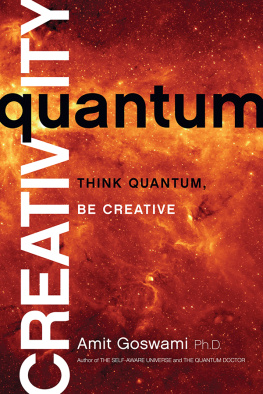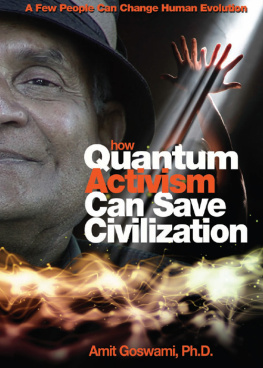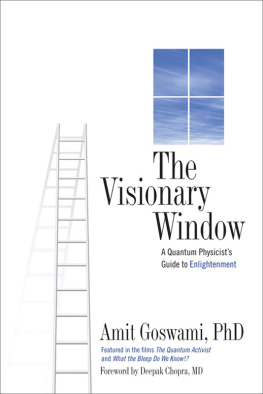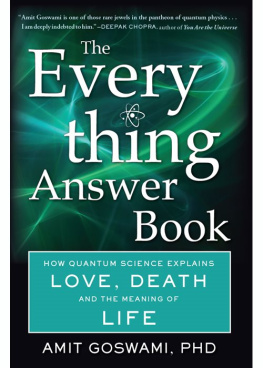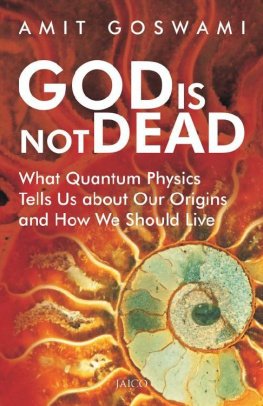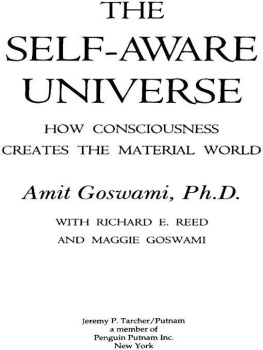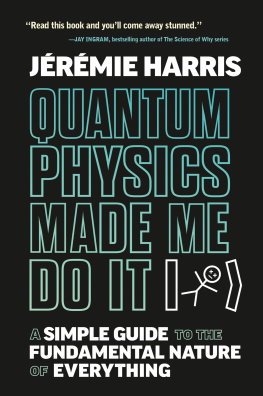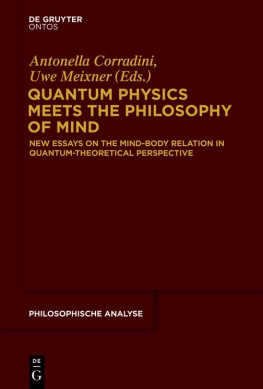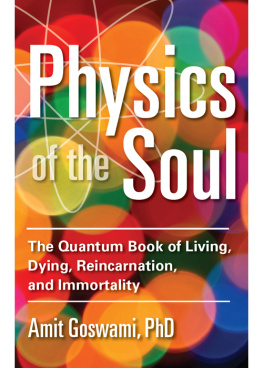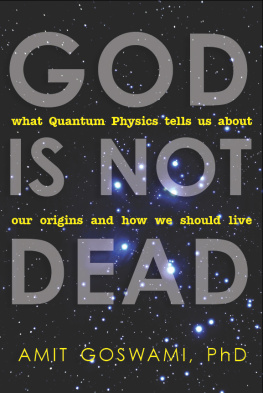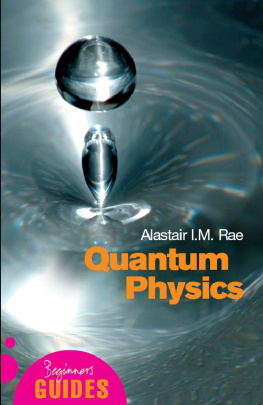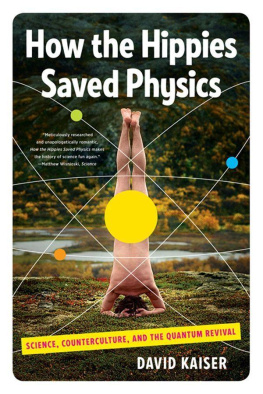Free e-Newsletters
from Hay House, the Ultimate
Resource for Inspiration
Be the first to know about Hay Houses dollar deals, free downloads, special offers, affirmation cards, giveaways, contests and more!
 | Get exclusive excerpts from our latest releases and videos from Hay House Present Moments. |
 | Enjoy uplifting personal stories, how-to articles and healing advice along with videos and empowering quotes within Heal Your Life. |
 | Have an uplifting story to tell and a passion for writing? Sharpen your writing skills with insider tips from Your Writing Life. |
Sign Up
Now! | Get inspired, educate
yourself, get a complimentary
gift, and share the wisdom! |
| http://www.hayhouse.com/newsletters.php |
Visit www.hayhouse.com to sign-up today
Praise for
quantum CREATIVITY
A new view of consciousness is arising, in which consciousness is infinite, eternal, and one. This new view has radical implications for the creative process, as physicist Amit Goswami shows in his splendid book, Quantum Creativity. In the new view, the solitary individual gives way to collective wisdom spanning past, present, and future. Thus the source of creativity and the fount of wisdom are potentially infinite. Goswami has painted a majestic picture of what it means to be human, on which our future may depend.
Larry Dossey, M.D., author of One Mind: How Our Individual Mind Is Part of a Greater Consciousness and Why It Matters
Amit Goswami writes with as much wisdom, intelligence, humor, and spiritual insight as his Bengali forefathersgreat minds like physicist Jagadish Chandra Bose, poet Rabindranath Tagore, and mystic Swami Vivekananda. Goswamis move from quantum physicist to motivational and spiritual teacher/writer takes considerable daring.
Fred Alan Wolf, a.k.a. Dr. Quantum, author of Time Loops and Space Twists: How God Created the Universe
ALSO BY AMIT GOSWAMI, PH.D.
The Self-Aware Universe
God Is Not Dead
The Quantum Doctor
Physics of the Soul
The Visionary Window
Creative Evolution
How Quantum Activism Can Save Civilization
Copyright 2014 by Amit Goswami
Published and distributed in the United States by: Hay House, Inc.: www.hayhouse.com Published and distributed in Australia by: Hay House Australia Pty. Ltd.: www.hayhouse.com.au Published and distributed in the United Kingdom by: Hay House UK, Ltd.: www.hayhouse.co.uk Published and distributed in the Republic of South Africa by: Hay House SA (Pty), Ltd.: www.hayhouse.co.za Distributed in Canada by: Raincoast: www.raincoast.com Published in India by: Hay House Publishers India: www.hayhouse.co.in
Indexer: Jay Kreider
Cover design: Angela Moody Interior design: Pamela Homan
All rights reserved. No part of this book may be reproduced by any mechanical, photographic, or electronic process, or in the form of a phonographic recording; nor may it be stored in a retrieval system, transmitted, or otherwise be copied for public or private useother than for fair use as brief quotations embodied in articles and reviewswithout prior written permission of the publisher.
The author of this book does not dispense medical advice or prescribe the use of any technique as a form of treatment for physical, emotional, or medical problems without the advice of a physician, either directly or indirectly. The intent of the author is only to offer information of a general nature to help you in your quest for emotional and spiritual well-being. In the event you use any of the information in this book for yourself, which is your constitutional right, the author and the publisher assume no responsibility for your actions.
Sydney Harris Cartoon printed by permission of Sydney Harris ScienceCartoonsPlus.com
Guernica 2013 Estate of Pablo Picasso / Artists Rights Society (ARS), New York
M.C. Eschers Drawing Hands 2013 The M.C. Escher Company-The Netherlands. All rights reserved. www.mcescher.com
On Beauty from THE PROPHET by Kahlil Gibran, copyright 1923 by Kahlil Gibran and renewed 1951 by Administrators C.T.A. of Kahlil Gibran Estate and Mary G. Gibran. Used by permission of Alfred A. Knopf, an imprint of the Knopf Doubleday Publishing Group, a division of Random House LLC. All rights reserved.
Library of Congress Cataloging-in-Publication Data
Goswami, Amit.
Quantum creativity : think quantum, be creative / Amit Goswami. 1st edition.
pages cm
Includes bibliographical references.
ISBN 978-1-4019-4075-1 (pbk.)
1. Creative ability. 2. Creative thinking. 3. Creative ability in business. 4. Quantum theory. I. Title.
BF408.G639 2014
153.35dc23
2013033280
Tradepaper ISBN: 978-1-4019-4075-1
17 16 15 14 4 3 2 1
1st edition, March 2014
Printed in the United States of America
Some of the results of my early exploration of a new understanding of reality based on quantum physics were published more than a decade ago in a book titled Quantum Creativity. It was written for scholars with the purpose of inviting academic researchers to consider quantum thinking in their exploration of creativity. This book draws on that earlier volume, hence the title, but this time Ive written for the layperson interested in seeing creativity, which includes the way we shape our life experience, in an entirely new way. By becoming aware of our role in a creative universe based on consciousness, we can align ourselves with the evolution of consciousness at a time when life on our planet is under duress.
My first adult experience of creativity occurred a year after I came from India to Case Western Reserve University in Cleveland, Ohio, as a young instructor and postdoctoral researcher in theoretical physics. I was working hard on research into a new kind of interactive phenomenon concerning atomic nuclei, but I wasnt making any progress. That day I had discussed the subject with my mentor, only to have him poke such serious holes in my research that it no longer held together even in my prejudiced eyes. Despondent, I retired to the Snakepit, the schools basement cafeteria, nearly ready to give up my research altogether. Then the solution suddenly came to me with such clarity that I knew it had to be right. I raced upstairs to my mentor, who immediately saw its value. I still remember the euphoric haze in which I spent the rest of the afternoon.
I continued my research in nuclear physics for ten more years after that incident, solved a great many problems, and wrote quite a few scientific papers, but rediscovering the joy of that day seemed to elude me. Gradually, I became a little cynical. I assumed, like most of my colleagues, that scientific research is creative, but that creativity is not necessarily joyful. People who reported such joy probably exaggerated; my own memorable experience was perhaps due to a beginners naive exuberance. I began to believe that creative work brought only the mature satisfaction that I felt each time I succeeded in solving a seemingly intractable problem, or writing another paper to further my career.
Next page
